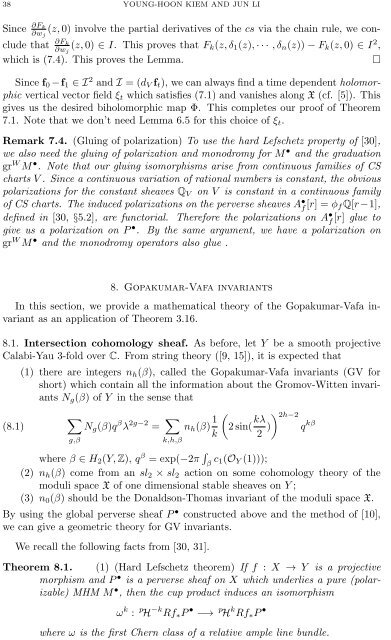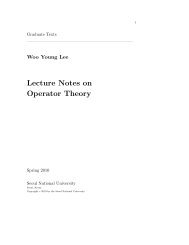Categorification of Donaldson-Thomas invariants via perverse ...
Categorification of Donaldson-Thomas invariants via perverse ...
Categorification of Donaldson-Thomas invariants via perverse ...
You also want an ePaper? Increase the reach of your titles
YUMPU automatically turns print PDFs into web optimized ePapers that Google loves.
38 YOUNG-HOON KIEM AND JUN LISince ∂F k∂w j(z, 0) involve the partial derivatives <strong>of</strong> the cs <strong>via</strong> the chain rule, we concludethat ∂F k∂w j(z, 0) ∈ I. This proves that F k (z, δ 1 (z), · · · , δ n (z)) − F k (z, 0) ∈ I 2 ,which is (7.4). This proves the Lemma.□Since f 0 −f 1 ∈ I 2 and I = (d V f t ), we can always find a time dependent holomorphicvertical vector field ξ t which satisfies (7.1) and vanishes along X (cf. [5]). Thisgives us the desired biholomorphic map Φ. This completes our pro<strong>of</strong> <strong>of</strong> Theorem7.1. Note that we don’t need Lemma 6.5 for this choice <strong>of</strong> ξ t .Remark 7.4. (Gluing <strong>of</strong> polarization) To use the hard Lefschetz property <strong>of</strong> [30],we also need the gluing <strong>of</strong> polarization and monodromy for M • and the graduationgr W M • . Note that our gluing isomorphisms arise from continuous families <strong>of</strong> CScharts V . Since a continuous variation <strong>of</strong> rational numbers is constant, the obviouspolarizations for the constant sheaves Q V on V is constant in a continuous family<strong>of</strong> CS charts. The induced polarizations on the <strong>perverse</strong> sheaves A • f [r] = φ f Q[r−1],defined in [30, §5.2], are functorial. Therefore the polarizations on A • f[r] glue togive us a polarization on P • . By the same argument, we have a polarization ongr W M • and the monodromy operators also glue .8. Gopakumar-Vafa <strong>invariants</strong>In this section, we provide a mathematical theory <strong>of</strong> the Gopakumar-Vafa invariantas an application <strong>of</strong> Theorem 3.16.8.1. Intersection cohomology sheaf. As before, let Y be a smooth projectiveCalabi-Yau 3-fold over C. From string theory ([9, 15]), it is expected that(1) there are integers n h (β), called the Gopakumar-Vafa <strong>invariants</strong> (GV forshort) which contain all the information about the Gromov-Witten <strong>invariants</strong>N g (β) <strong>of</strong> Y in the sense that∑(8.1)N g (β)q β λ 2g−2 = ∑n h (β) 1 (2 sin( kλ ) 2h−2k 2 ) q kβg,βk,h,βwhere β ∈ H 2 (Y, Z), q β = exp(−2π ∫ β c 1(O Y (1)));(2) n h (β) come from an sl 2 × sl 2 action on some cohomology theory <strong>of</strong> themoduli space X <strong>of</strong> one dimensional stable sheaves on Y ;(3) n 0 (β) should be the <strong>Donaldson</strong>-<strong>Thomas</strong> invariant <strong>of</strong> the moduli space X.By using the global <strong>perverse</strong> sheaf P • constructed above and the method <strong>of</strong> [10],we can give a geometric theory for GV <strong>invariants</strong>.We recall the following facts from [30, 31].Theorem 8.1. (1) (Hard Lefschetz theorem) If f : X → Y is a projectivemorphism and P • is a <strong>perverse</strong> sheaf on X which underlies a pure (polarizable)MHM M • , then the cup product induces an isomorphismω k : p H −k Rf ∗ P • −→ p H k Rf ∗ P •where ω is the first Chern class <strong>of</strong> a relative ample line bundle.













